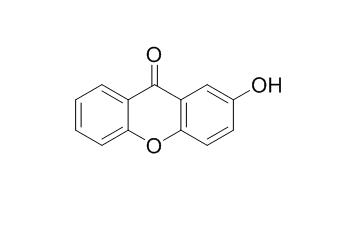2-Hydroxyxanthone
2-Hydroxyxanthone is a natural product from Calophyllum inophyllum.
Inquire / Order:
manager@chemfaces.com
Technical Inquiries:
service@chemfaces.com
Tel:
+86-27-84237783
Fax:
+86-27-84254680
Address:
1 Building, No. 83, CheCheng Rd., Wuhan Economic and Technological Development Zone, Wuhan, Hubei 430056, PRC
Providing storage is as stated on the product vial and the vial is kept tightly sealed, the product can be stored for up to
24 months(2-8C).
Wherever possible, you should prepare and use solutions on the same day. However, if you need to make up stock solutions in advance, we recommend that you store the solution as aliquots in tightly sealed vials at -20C. Generally, these will be useable for up to two weeks. Before use, and prior to opening the vial we recommend that you allow your product to equilibrate to room temperature for at least 1 hour.
Need more advice on solubility, usage and handling? Please email to: service@chemfaces.com
The packaging of the product may have turned upside down during transportation, resulting in the natural compounds adhering to the neck or cap of the vial. take the vial out of its packaging and gently shake to let the compounds fall to the bottom of the vial. for liquid products, centrifuge at 200-500 RPM to gather the liquid at the bottom of the vial. try to avoid loss or contamination during handling.
International Food Research Journal2018, 25(6):2560-2571
Plants (Basel).2020, 9(11):1555.
Ajou University2024, 4688116
J Ethnopharmacol.2020, 249:112396
Phytomedicine.2023, 116:154841.
Molecules.2021, 26(23):7390.
Molecules.2023, 28(10):4062.
Foods.2020, 9(10):1348.
Dent Mater J. 2024, dmj.2023-294.
Sci Rep.2018, 8:15059
Related and Featured Products
Isogentisin
Catalog No: CFN70382
CAS No: 491-64-5
Price: Inquiry(manager@chemfaces.com)
1,7-Dihydroxy-4-methoxyxanthone
Catalog No: CFN89322
CAS No: 87339-76-2
Price: Inquiry(manager@chemfaces.com)
1,3,7-Trihydroxy-2-methoxyxanthone
Catalog No: CFN89266
CAS No: 211948-69-5
Price: Inquiry(manager@chemfaces.com)
1,7-Dihydroxy-2,3-dimethoxyxanthone
Catalog No: CFN89239
CAS No: 78405-33-1
Price: Inquiry(manager@chemfaces.com)
1,7-Dimethoxy-2,3-methylenedioxyxanthone
Catalog No: CFN89256
CAS No: 145523-71-3
Price: Inquiry(manager@chemfaces.com)
1,2,3,7-Tetramethoxyxanthone
Catalog No: CFN89234
CAS No: 22804-52-0
Price: Inquiry(manager@chemfaces.com)
1-Hydroxy-2,3,4,7-tetramethoxyxanthone
Catalog No: CFN96239
CAS No: 14103-09-4
Price: Inquiry(manager@chemfaces.com)
1,2,3,4,7-Pentamethoxy-9H-xanthen-9-one
Catalog No: CFN98534
CAS No: 14254-96-7
Price: Inquiry(manager@chemfaces.com)
1,5-Dihydroxyxanthone
Catalog No: CFN89131
CAS No: 14686-65-8
Price: Inquiry(manager@chemfaces.com)
5-Hydroxy-1-methoxyxanthone
Catalog No: CFN96278
CAS No: 27770-13-4
Price: Inquiry(manager@chemfaces.com)
J Asian Nat Prod Res. 2008 Sep-Oct;10(9-10):993-7.
Cytotoxic prenylated xanthones from Calophyllum inophyllum.[Pubmed:
19003621]
METHODS AND RESULTS:
A new prenylated xanthone (1), named caloxanthone N, together with two known constituents, gerontoxanthone C (2) and 2-Hydroxyxanthone (3), was isolated from the ethanolic extract of the twigs of Calophyllum inophyllum. Their structures were completely elucidated using a combination of 1D, 2D NMR techniques (COSY, HMQC, HMBC, and ROESY) and HR-ESI-MS analyses.
CONCLUSIONS:
Compounds 1 and 2 exhibited cytotoxicity against chronic myelogenous leukemia cell line (K562) with IC50 values of 7.2 and 6.3 microg ml(- 1), respectively.



